If you’re tired of working with a stagnant marketing funnel that consumes resources but doesn’t show any results, you’re not alone. Many people have found that there are issues with the marketing funnel format.
The marketing funnel is based on a traditional market structure that simplifies consumer behaviors and journeys. They are often ineffective because your strategies are based on a consumer that no longer exists. The traditional marketing funnel design overlooks a customer’s value to the brand.
There is a way to end your frustration with the marketing funnel, but you will need to let go of some old-fashioned aspects of the funnel. Below, we’ll walk through some common marketing funnel issues and how to resolve them.
11 Marketing Funnel Problems
1. Simplifies Marketing Process
This is a common issue that is a cause of many marketing funnel failures. The marketing funnel operates in a traditional way without adjusting to the dynamics of digital technology.
Since a majority of today’s marketing takes place on digital platforms, there are many different ways for consumers to reach a brand.
At the same time, they might never be able to reach it because of the Internet’s vast size. As a result, your marketing funnel will fail miserably when these complex and crucial factors are not accounted for.
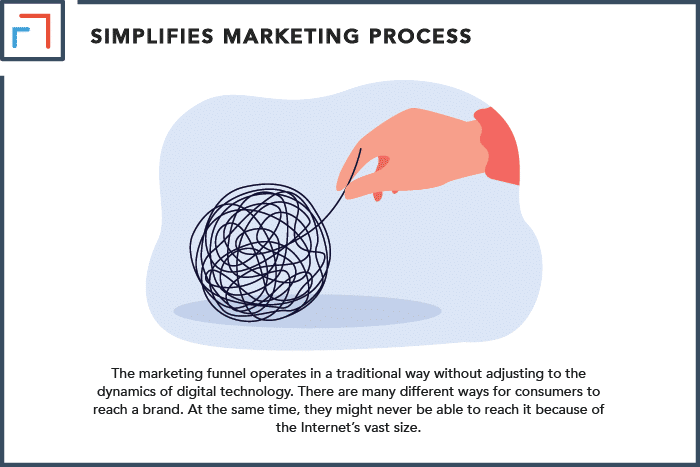
2. Perceives Consumers To Be Singular
Your customers do not have a hive mind, so they won’t all have the same thought processes. This means they won’t all respond the same way to your strategies.
Some of them might require more stages to bring them to a point that another customer reached instantly. Successful brands also develop niches so they can target specific audiences.
As a marketer or entrepreneur, you can save yourself a lot of frustration by acknowledging early on that all of your customers (or at least most of them) won’t behave in the same way.
3. Incompatible With Consumer Behavior
The marketing funnel is based on a traditional model of consumers and media platforms. Therefore, it also suggests a marketing structure that does not align with modern consumers.
Nowadays, customers prefer to research brands on their own before engaging with them. This way, they are exposed to market competitors and can make their own judgments about the brands.
For instance, if a consumer sees a competing brand boast their sustainability practices, but your brand does not, they can easily lean towards the environmentally-conscious brand.
Similarly, a consumer might read your company’s blog, but most would find it easier to engage with another brand through their TikTok page.
4. Marketing Strategies Based On Sales
Many marketing teams are busy designing their strategies around how many sales the company made the previous month and how many it needs to secure in the present.
If the company needs to increase its sales, marketers tend to focus squarely on inflating brand awareness. Your company may already be popular enough in the market.
Spending more time and resources on brand awareness can remove marketers from their actual role. The marketing funnel presents its own data, which is not linked to the sales funnel.
However, the funnel is being used by the marketing team for sales. In short, using a marketing funnel like a sales funnel is a recipe for disaster.
5. Traditional Approach To Customer Value
The marketing funnel has an outdated outlook of a customer. They only view them as a form of value that feeds into a company.
Customer value is considered to be a transaction (or a series of repeated transactions).
This way, strategies are implemented to persuade customers to spend money on the brand’s service or products.
Unfortunately, this understanding of customer value is limited and overlooks the ways that customers help a company grow outside of sales.
For instance, loyal customers help build communities around brands. Moreover, customer surveys and feedback provide a lot of data to a business about how to improve its service.
6. Marketing Success Equated With Sales Success
Since a marketing funnel operates differently than a sales funnel, its success cannot be measured in the same way. It is essential to set marketing goals that are separate from the goals of the sales team.
However, this doesn’t mean that the two groups (marketing and sales) should be disconnected from each other in their approach.
The leads that the marketing team passes along to the sales funnel need to align with the marketing goals. For instance, these goals could include nurturing customers who relate to the brand.
You then help them form a connection to your business.
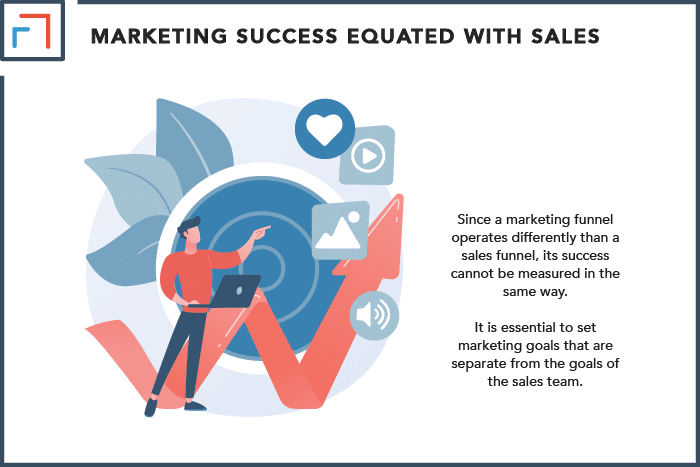
7. Brand Centered Approach
How can your marketing funnel be effective for your target audience if it is centered around the needs of your business? Funnel stages are being designed in order to build an empire for the business.
Consider evaluating the way you market your business. Check if your branding depends on how you want your business to be perceived or how your target customers would want it to be.
If these two are aligned, you have a customer-centric approach. If they aren’t, then you’ll know why your marketing funnel is failing.
8. Overlooks Importance Of Customer Loyalty
The standard marketing funnel aims at pushing the consumer from one stage to the next. It doesn’t consider the possibility of the roles being reversed.
This is where a valuable marketing opportunity is being missed. Marketers who are constantly updating their funnel understand how customer loyalty can carry out half of their marketing work.
However, in the traditional funnel, loyalty lies at the final stage and barely receives any attention.
9. Funnel Stages Lack Integration
Your marketing funnel needs to be connected from one stage to the next, like the rungs of a ladder. If this isn’t the case, your marketing approaches will experience a lot of friction.
This is because there is a gap between each stage which slows down your marketing process.
As a result, you also lose some consumers. Unless you notice the gaps between your funnel steps, you won’t understand why your target audience is losing interest and backing away.
10. Underestimates The Dark Funnel
When we’re talking about gaps in your funnel, another important reality of the process is the dark funnel, which is the action behind the curtains.
The dark funnel is a recently coined term, but the concept has existed for a while.
In the same way your marketing team is busy planning out every stage of the funnel behind the curtains, the consumer is also processing their experience on the backend.
This includes going on platforms (such as Reddit and Quora) where users are candid about their problems and how they feel about a brand.
At this point, the consumer makes decisions based on interactions with these communities. Therefore, you’re sorely mistaken if you consider your marketing funnel the sole source of information.
11. Ends At Conversion
Traditionally, a marketing funnel ends when leads are qualified enough to be sent to the sales team. The effort that was put in to attract, inform, and engage with a customer is lost if you end the funnel here.
Hence, designing a marketing funnel with a finite end will waste all the good work you’ve put in at the top.
Fixing Your Marketing Funnel
1. Consumer Segmentation
Build multiple audience personas based on different categories, such as demographics, behaviors, psychographics, interests, etc.
By creating subgroups within your target consumer base, you can create multiple funnel pathways to better target your approach.
Your consumer segmentation will help you identify needs and refer certain content to specific subgroups.
This way, you can also prioritize your most crucial audience and design your strategies to engage with them.
In addition, this will help you identify which subgroups are responding positively to your marketing. You can then filter out the ineffective tactics.
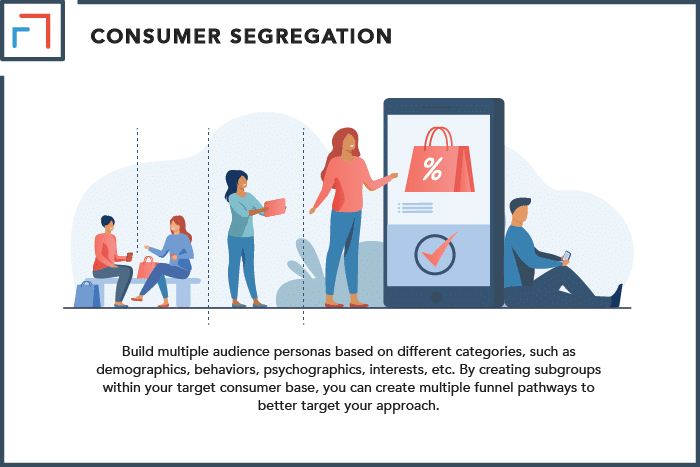
2. Deliver Targeted Value
You may already be promoting your brand’s unique selling proposition. But how targeted is this USP to the needs and desires of your audience?
Using the information from your consumer segmentation, determine the best possible offer that will connect potential customers with your company.
Remember that the value you offer doesn’t have to be a grand gesture. This could even include providing an easy shopping experience through a user-friendly interface or constant customer support.
Since modern consumers are more concerned with having a good experience, use this to your benefit and deliver what they’re looking for.
3. Integrate Your Marketing
Write down your reasons for choosing each strategy for every stage of your funnel. Map out how each stage helps the one before and after it.
Visualize your marketing channels before launching your funnel so you can understand how each step will flow into the next one.
As we mentioned previously, customers are unpredictable and can enter your funnel at any point.
Knowing this, design each stage so that it takes your “abruptly landing” consumer towards your primary marketing goal.
This also means that your funnel must include adaptable copy and design elements.
4. Be Customer Centric
By now, you must have realized the crux of an effective funnel. Your funnel needs to revolve around your customers.
If you’re designing your marketing funnel solely based on your business goals, your customers will feel disconnected sooner or later.
If you’re serving your customers, it only makes sense to plan everything around them. Therefore, you’ll need to develop a genuine tone of voice with your customers.
This shows them that you want to build a long-lasting connection with them. Similarly, add chatbots and customer feedback forms to your funnel.
This strategy lets your customers know that their opinion is wanted and valued.
5. Build Loyalty
Your marketing funnel should always have a final stage for building loyalty. It needs to go beyond a single step, though.
Customer loyalty is an ongoing process that should be built up throughout every stage of your funnel.
Use your landing page copy and content marketing to show that you know your customers and are aware of their problems. If you want to make a bigger power move, act on the customer feedback.
Send them articles or blogs on their requested topics, and watch your brand community flourish.
Another effective approach is to set up a reward system for your consumers. Maybe they can get a discount or a free product for sharing your content or reaching a milestone as a subscriber.
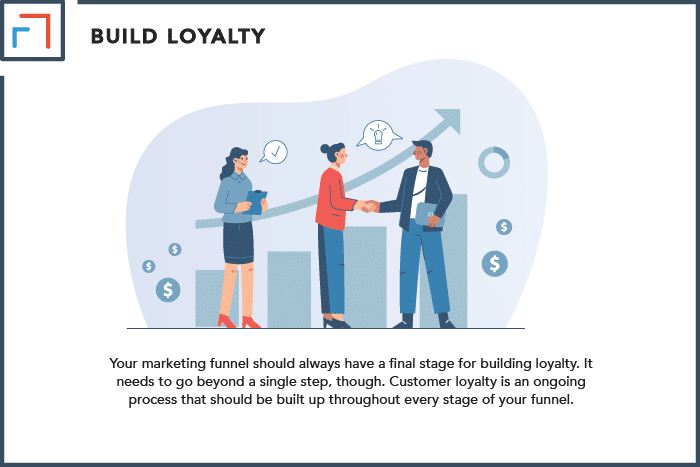
6. Use Creative Data, Design & Content
Build your credibility with interesting and relevant statistics. Your audience should want to read this data, so this is where infographics and graphs come in.
The visual data will also keep your audience engaged for a longer amount of time, which will improve your website’s search engine ranking.
Similarly, use innovative designs that appeal to your target consumers’ aesthetics.
You can maintain your brand identity by repeating distinct design elements at every stage of your funnel. Stay abreast of popular design trends, such as the popular Dark Mode feature.
For your users’ comfort and convenience, you can include a dark version of your web pages.
Though you can also incorporate storytelling visually, it is an important part of your articles, blogs, and webinars.
By using storytelling, companies appear less like brands and more like communities based on shared human experiences.
This is an efficient way for you to connect with your customers and help them associate certain emotions with your business.
7. Set Clear Marketing Goals
Goals and strategies should be based on consumer problems. Therefore, your marketing funnel goals must be distinguishable from the sales funnel.
These goals should then work towards the brand mission, not just profits and purchases.
8. Use Word Of Mouth
Your customers offer more value to your company than just increasing sales. Referrals and customer-generated content are two indicators that your marketing is working well.
And if it isn’t, then this is what you need to work towards. You must acknowledge the value of your customer because their recommendation is more trustworthy than a marketer’s.
With word of mouth, marketers can effectively increase brand awareness as well as engagement using consumer-generated content.
9. Consistent Brand Experience
Since you’re developing customer relationships as a marketer, ensure that every aspect of your funnel is consistent with your brand identity.
For your customers to be familiar with your brand, your design, voice, and copy must be recognizable (regardless of the platform).
As a result, every strategy needs to be designed to maintain and improve your customer’s perception of the company.
If the quality of your customer service, web designs, or content wavers, you risk losing customer confidence.
10. Use Analytics
Rely on metrics to understand your consumer journey better. Assess how the trajectory of your consumer highlights how effective your funnel stages are.
By looking at the metrics and data, you can figure out how many consumers reached a certain point through a strategy and how many you would like to reach in the future.
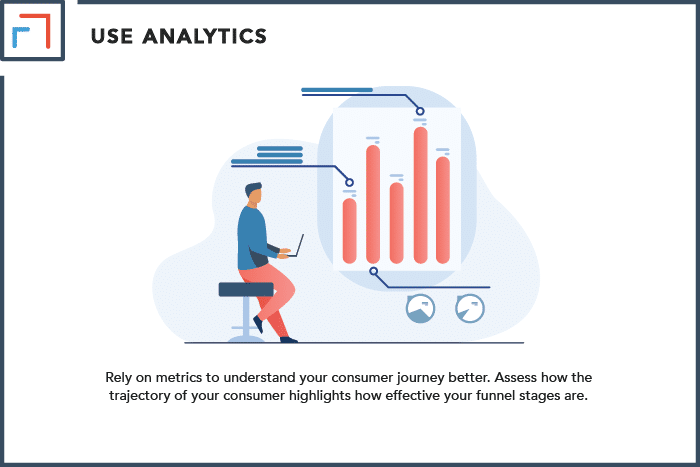
Key Takeaways
The market evolves with time and technology, and so does the customer. So if you’re still using an older and irrelevant version of the marketing funnel, you need to level up.
A marketing funnel is an ongoing process. If you keep working on improving it, your work as a marketer will become more satisfying. Focus on customer-centric strategies to improve your results.
